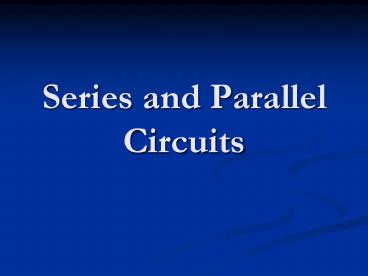Series and Parallel Circuits PowerPoint PPT Presentation
1 / 18
Title: Series and Parallel Circuits
1
Series and Parallel Circuits
2
Review of Chapter 22
- A flow of charged particles is called an electric
Current. - A Flow of one Coulomb/second is equal to 1
ampere. We write this as 1A - A device for measuring current is an Ammeter.
- The potential energy of an electrical charge is
termed the Electric Potential Difference. - Electric Potential is measured in Joule/Coulomb
and is called the Volt (V) - A device for measuring Voltage is a Voltmeter.
3
Review of Chapter 22
- Resistance (R) is the opposition to current flow
and is represented by the Ohm (O). - Ohms Law is R V/I
- Power (P) is the energy/time converted into some
other form of energy by the circuit. - Power is measured in Watts (W).
- To find Power P VI or P I2R
- Energy Pt (Power x time) or E I2Rt in Joules
(J)
4
Some Symbols
5
Example of a Simple Circuit
The Voltmeter is measuring across a battery and
resistor. The ammeter is measuring current
through the circuit.
6
Series and Parallel Circuits
- Objective of this chapter
- Discuss Series Circuits
- Identify Voltage Drops in a Series Circuit
- Discuss Parallel Circuits
- Identify Voltage Drops is a Parallel Circuit
- Equivalent Resistance
- Ammeters and Voltmeters
7
Series Circuits
- Only one Path for current to flow through.
- All current travels through each resistor.
- The total resistance of the circuit is the sum of
all resistors in the circuit. R R1 R2 R3 - The Current through the circuit is
I V/(R1 R2
R3) - The Voltage V V1 V2 V3
- Find the equivalent resistance and then use
R V/I
8
Series Circuit Example
E 120V and R1, R2 and R3 are all 20 O
resistors. What is the effective resistance of
the circuit? What is the current in the circuit?
9
Voltage Drops in a Series Circuit
- The change in Electric Potential around a series
circuit is Zero. - If you have a 9V battery, the voltage dropped
around the circuit will equal -9V - The circuit to the right is called a Voltage
Divider
A1
ms
V1
5 oh
E
R1
45V
10 ohms
V2
R2
10
Parallel Circuits
- In a Parallel circuit there are many paths for
current to follow. Current follows the path of
least resistance. - The Potential Difference is the same across each
path. - The total current is the sum of the currents in
each path I I1 I2 I3 - The equivalent resistance is found by
- 1/R 1/R1 1/R2 1/R3
11
Equivalent Resistance
- 1/R 1/R1 1/R2 1/R3
12
Parallel Circuits
If R1 60 ohms, R2 30 ohms, R3 20 ohms , E
90V a) Find Req b) Find I for the
circuit c) Find I for each branch circuit
13
Combined Circuits
- Many circuits combine both series and parallel
circuits. - Using combined circuits enables a wide variety of
controls over current and voltage. - Simplifying these circuits consists of 3 steps
- If resistors are in parallel, replace with an
Req. - If Resistances are then in series, determine the
new Req - Repeat steps 1 and 2 until the circuit is reduced
to an equivalent resistance.
14
Req in a Combined Circuit
Simplifying these circuits consists of 3
steps If resistors are in parallel, replace with
an Req. If Resistances are then in series,
determine the new Req Repeat steps 1 and 2 until
the circuit is reduced to an equivalent
resistance.
15
Voltmeters Ammeters
- Voltmeters are used to measure voltage drop
across some part of a circuit. - Voltmeters have a very high resistance 10MO
- Ammeters measure current through the circuit.
- Ammeters have a very low resistance.
- Voltmeters work in Parallel.
- Ammeters work in Series.
16
Recap
- Series Circuits have one path for current.
- Parallel Circuits have many paths for current.
- Series Req is R1R2R3R4 etc.
- Parallel Req 1/R(1/R1)(1/R2)(1/R3) etc.
- Combined Circuits need to be simplified in a step
by step manner. - Ammeters work in series while voltmeters work in
parallel.
17
Housekeeping
- Tutorial tomorrow evening covering waves and
sound. - Test Friday Morning.
- Labs this week will investigate various circuits.
- Assignment for Chapter 23
- Problems 1, 5, 6, 10, 13, 14, 15, 16, 17, 18
- Due as per normal assignment guidelines.
- You can find my website (with physics stuff) at
http//electronics.saintjohn.nbcc.nb.ca/mcdevitt/
18
Thank You

